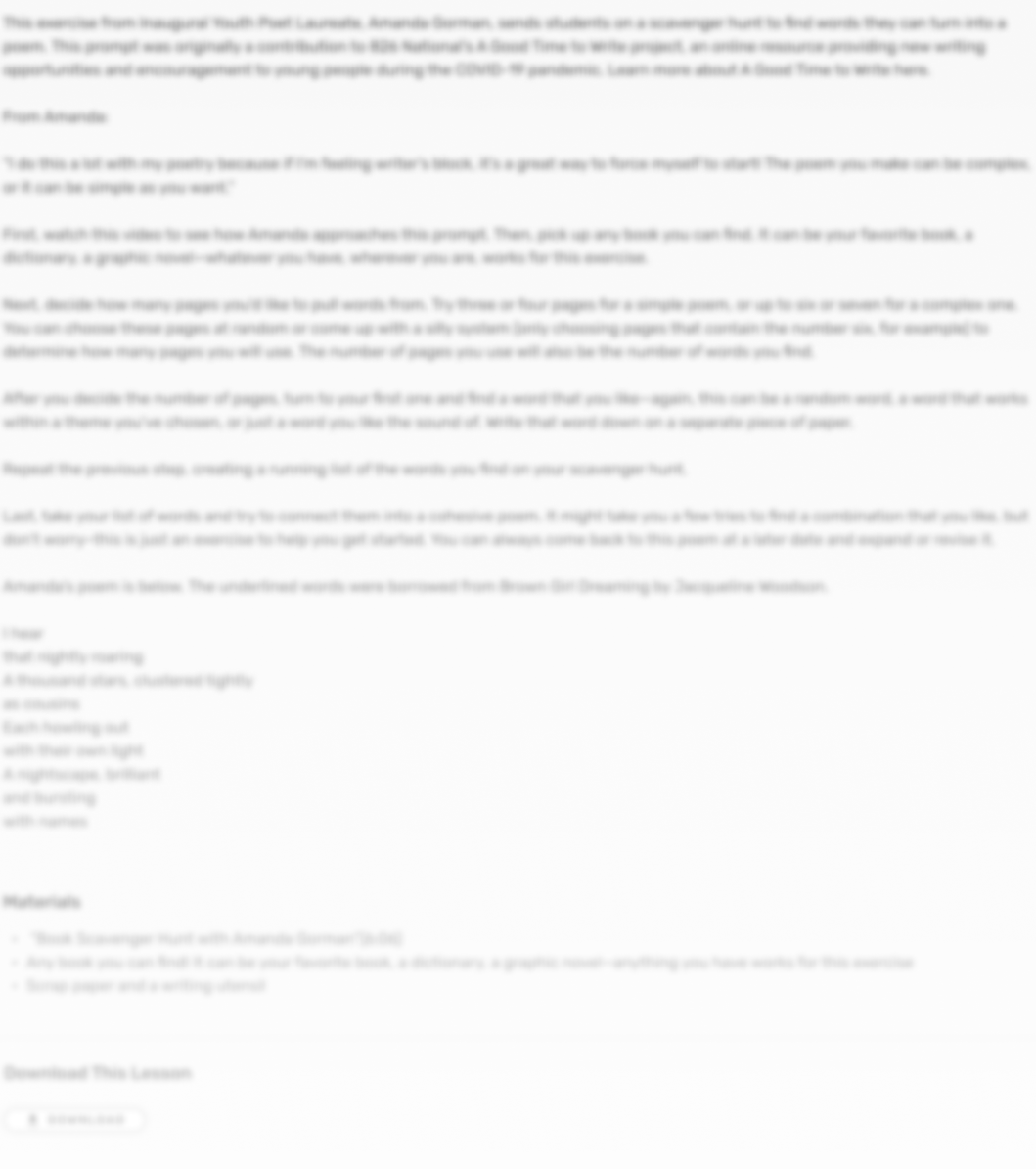 Grades 6–8
Grades 6–8 1 Session, 1 Hour
1 Session, 1 Hour Narrative
Narrative Sparks
Sparks
Leah Tribbett (she/her) teaches 7th grade ELA and Social Studies in Boston, Massachusetts. In her role, Leah has written original curriculum, planned and led both department and whole staff PD, managed a whole school curriculum around identity, and mentored new teachers.
Students will learn how to write authentic dialogue that reveals information about the characters, plot, and conflict.



Students will produce dialogue that’s authentic to the characters and to themselves.
Note to Educators: This mini-lesson is designed to support students as they write narratives. We recommend teaching the lesson before students develop the rising action of their narratives, so that they can practice using authentic dialogue as a tool for characterization and plot development.
Introduce the focus question: Why is authentic dialogue important?
Framing
Frame the purpose of the day with students: “I know I don’t have to tell you that dialogue is essential to a good story! We’re going to really focus on what authentic—or real dialogue looks like, but first, check in with your partner and remind each other what rules we always, always have to follow with dialogue.”
Give students 1-2 minutes to check in before reporting back.
Review “the rules”:
No spaces between the quotation marks and dialogue A space between the dialogue and the rest of the sentence...

by Spike Jonze, award-winning screenwriter and producer
A pair of prompts that invites students to consider how time, location, and dialogue can be used to construct a scene and build meaning.
by Jillian Wasick, 826 Valencia
To jumpstart their own poems, students take inspiration from the poetry of the others.
by 826 National, in partnership with Academy of American Poets
In this Spark, students will learn more about voice: what it is exactly, and how to name the elements of it.
by Aracelis Girmay in collaboration with Aarti Monteiro & Nico Garbaccio, 826NYC
What lives inside a word? Find out how to trace connections between two dissimilar words with this playful Spark from award-winning poet Aracelis Girmay.
Inspired by Kendra Lappin, 826 Valencia
In this Spark, students will play a game of bingo to improve their narrative writing.
by 826 National
Engage young writers of any age at home with this collection of 826 Digital writing prompts and activities.
by 826 National, in partnership with Academy of American Poets
In this Spark, students will explore the many ways you can connect to a poem.
by Molly Sprayregen, 826CHI
Students consider the influence that labels hold and write poetry to become empowered to describe themselves however they want.
by David Ehrenhaft
Daniel Ehrenhaft asks students to consider perspective in a piece of their writing with this reflective spark.
by Meredith Goldberg-Morse, 826LA
In this activity, students write about a cause they are passionate about and imagine how they can create change in the world.
by Lindsay Stinson, 826LA
Students will learn to be empathetic towards those who are different by brainstorming scary characteristics of specific monsters and then developing more positive aspects to their nature.
by 826 National
These 10 prompts ask students to browse the 826 Digital Student Writing Gallery for writing inspiration.
by Maria Villareal, 826CHI
This activity prompts students to write words unspoken, in letters undelivered.
by G.D. Falksen
Students draw inspiration from a real or fictional location and use this sense of place to develop an in-setting document.
by Kelly Jensen, writer and editor
Make space for creativity in nonfiction! Students will play with traditional nonfiction formats with these two writing prompts from Kelly Jensen, writer and editor.
by Phil Stamper, author
With this pair of prompts, students look to the past and future for writing inspiration.
by Jane Roschen, 826LA
In this activity, students will explore superhero traits or superpowers that they know or admire. What kind of jobs do they do? How do their powers help them achieve this?
by Paris Hyun, 826LA
Students will use creative thinking to innovate an imaginary elixir that targets a problem they see in the world.
by Louise McCune, 826 Valencia
Students play a spin-off version of Balderdash in this activity, working as budding archeologists who must use the power of observation to solve a few artifact mysteries.
by Laura Lisabeth, Ph.D., 826NYC
In this activity, students explore Instagram as a form of public rhetoric and practice using hashtags as a way to engage with larger communities.
by Pedro Estrada, 826LA
In this activity, students will examine narrative structure, explore the purpose and practice of myths, and put the two together to create their own original piece.
by author Tiphanie Yanique
In this Spark, students will explore two taboo emotions, desire and fear, by mapping where these feelings dwell in their bodies and using tactile language to describe their impact.
by Mariama Lockington, novelist and poet
Students revisit powerful memories to generate personal stories filled with heart.
by Christopher Ankney, Tom Bianchi, & Amy Wilson, 826michigan
In this fun, interactive game, students will build an understanding of the concept of synonyms. A strong grasp on how to use synonyms will improve students’ overall writing skills.
by 826 National, inspired by student authors of 826 New Orleans
Usually, an ode is written in celebration, but this Spark asks students to write an anti-ode—a poem about something they can’t stand!
by Mariama J. Lockington and Peter Calhoun Hall, 826NYC
In this Spark, students will write haikus from two different perspectives, one of a hero and one of an engineer, to design a secret lair for a superhero.
by, Laura Lisabeth, Ph.D., 826NYC
Students will interview each other in order to create an interesting written portrait. This is a great exercise in journalistic writing and the ability to work together with classmates.
by Julius Panoriñgan, 826LA
Students will use their knowledge of popular music to learn basic computer programming concepts.
by Nathalie Lagerfield, 826CHI
Students will imagine (and write about) their own fantastical worlds, using the cover illustrations of magazines as inspiration.
by Rachel Eliza Griffiths
This poetry prompt from Rachel Eliza Griffiths asks students to consider the ordinary in their lives—then write a poem that celebrates those ordinary objects and figures.
by author and activist P. Carl
Author and activist P. Carl asks students to write dialogue that captures two distinct and opposing voices, crafting a scene of action and discord.
by 826 National
Candy hearts are a Valentine’s Day staple, with their funny—even punny—sayings about love. In this Spark, students will lean into the world of youth slang to write some “sweet” sayings of their own.
by Jessica Goodman
This Spark uses students’ favorite things to support their persuasive writing practice.
by 826 National
By combining two classic games, students will learn how storytelling and art can build community or help them break through writer’s block.
by Klariza Alvaran, 826CHI
This spark activity is designed to get your students on their feet while reinforcing the need for strong dialogue in narratives.
by Amanda Gorman, Inaugural Youth Poet Laureate of the U.S. and 2021 Inaugural Poet
Students recall “last times” in their lives and revisit the depth of their experience through writing.
by Neil Gordon, 826LA
Students teach a "pirate" how to make a peanut butter and jelly sandwich and learn how to give effective instructions in the process.
by Asia Calcagno, 826CHI
Writing can be a powerful tool when working through feelings of grief, sadness, or anger. This Spark creates an intentional opportunity for youth to write and speak about what is on their minds.
by Cristeta Boarini, 826 MSP
Author bios offer students another opportunity to express themselves through writing and to feel like a real author. This Spark walks students through the process of writing one.
by Daniel José Older, author of Flood City
This Spark introduces students to the fantastical world of Flood City and prompts them to write a journal entry from the perspective of a Flood City resident.
by 826 National
Students discuss the 2021 inaugural poem by Amanda Gorman and write their own poems in response to "The Hill We Climb."
by Maria Villarreal, 826CHI
In this activity, students draw upon inspiration from existing text and the world around them to launch stories of their own.
by Catherine Calabro and Rachel Feder, 826michigan
A fun, free-writing task which challenges students to take cheesy pop lyrics and make them into their own original poems.
by the Team at 826CHI, with inspiration from Ryan Harty, 826michigan
In this activity, students practice analyzing a character’s internal motivations and fears and develop their own original characters.
by Mindy Misener, 826michigan
This activity encourages young writers to identify the rules in their own poems and to then experience the joy of either smashing the rules outright or finding a graceful way to reimagine them.
by Louise McClune, 826 Valencia
In this activity, students work as budding archeologists and creatively reimagine ways for archaeologists and historians to use artifacts to tell stories.
by 826 National
This Spark provides students with the opportunity to get to know their classmates by sharing personal stories about a specific topic.
by Jason Reynolds, The New York Times Best-Selling Author & National Ambassador for Young People’s Literature
Students will write a personal narrative where they describe themselves as a place. Not a specific place, but all the things a "place" consists of.
by 826 National, in partnership with Academy of American Poets
What words do we carry with us? This Spark introduces students to the Poem in Your Pocket Day celebration and invites them to create a pocket-sized poetry zine.
by Rebecca Stead
Using a place with personal meaning, students will learn a strategy for getting over the hurdle of beginning the writing process.
by The New York Public Library
At a time of rising book bans, The New York Public Library invites all teens to reflect on the essential freedom to read.
by Bryan Wilson, Educator Leader, Bureau of Fearless Ideas
In this lesson students will work together to revise a scene from a first draft by adding descriptive details.
Inspired by Angela Iton and Precediha Dangerfield, 826 Valencia
In this Spark, students will play a game of bingo to improve their poems!
by Ada Limón
This poetry prompt from Ada Limón invites students to consider a personal connection to an animal.
by Dave Eggers, 826 Valencia & 826 National
Students will collectively create a running list of golden details—details and descriptions that are singular, completely original, and make one's subject unforgettable.
by 826 National
With a little folding and loads of creativity, students make their own zines that feature abstract recipes.
by Maria Villarreal, 826CHI
In this activity, students illustrate a favorite word and explore what makes words meaningful through illustration, research, and discussion.
by author Lisa Ko
This writing prompt from author Lisa Ko invites students to explore the impact of social movements by envisioning and writing from an ideal future.
by Debra Mitchell, 826CHI
Students pose questions to the magic 8 ball in this activity centered on character motivation.
by Dave Eggers, 826 Valencia & 826 National
Through a series of short drawing activities, students will explore the ways observable details can have a major impact on their writing.
by Ashlyn Anstee, 826LA
Students will be asked to take an existing 4-panel comic and create their own dialogue. This is a fun quick activity or warm-up exercise that will challenge students to write efficiently.
by Jillian Wasick, 826 Valencia
What are students made of? This activity prompts students to reimagine recipes and write about their life experiences.
by Aarti Monteiro, 826NYC
This activity explores the way emotions change how we perceive settings. Students work in groups to create descriptions of apartments based on an emotion they draw from a hat.
by Maria Villareal, 826CHI
In this activity, students begin with the most essential details from various memories, helping them hone in on specifics without getting caught up in writer's block.
by Kiley McLaughlin & Dana Belott, 826 Valencia
Students experiment with alternative ways of writing poetry by reordering and rearranging pre-existing text.
by Ola Faleti, 826CHI
Students draw inspiration from powerful change-makers to write celebratory, haiku poetry.
by Leslie Margolis
Leslie Margolis invites students to consider their own personhood and what determines or defines it with two short prompts.
by Karen Russell, novelist and short story writer
A hauntingly good pair of prompts! Students will reconsider the purpose of ghosts by either describing a haunted setting or writing from the perspective of a misunderstood ghost.
by 826 National
The Character-O-Matic is a writing tool that helps students to create new characters. In this lesson, students will use it to create a character profile that reflects their own identies.
by Shavonde Chase, 826 Digital Educator Leader
In this writing prompt, students are asked to reflect on the choices they make when deciding whether or not to help someone.
by 826 National
Students consider perspectives of activists speaking up against racism and police brutality following the death of George Floyd and use imagery to capture protest scenes in writing.
by Isaac Fitzgerald
In this Spark, students will mine their home and their habits for story and personal essay ideas.
by the Team at 826CHI
In this activity, students create original monsters in archetypal protagonist and antagonistic roles by focusing on internal and external characteristics.
by Anna Griffin, 826 National
Students plot significant memories on a timeline in this reflective writing activity.
by Aarti Monteiro, 826NYC
Students identify the power of imagery in poetry, then practice putting this power to use in a poem about their neighborhood.
by 826 National
This activity reinforces the role of dialogue in a story, with students creating realistic conversation in A-Z fashion.
by the Team at 826CHI
Students learn to incorporate setting as a key element of a story, starting with inspiration from collages.
by Katie Manning and Brandon Brown, 826LA
Students enter a Writing Laboratory, no lab coats required, and use methods of observation to embark on their writing process.
by Maria Villareal, 826CHI
An effective writing prompt about a significant threshold.
by Julianna Lee Marino, 826NYC
In this Spark, students put on their detective hats and sleuth out places to add more details into their writing.
by author Daniel Handler, a.k.a. Lemony Snicket
Students will anthropomorphize an inanimate object to produce interview questions and answers.


We are thrilled to have you as the newest member of our online community. Stay up-to-date on the the latest and most relevant resources, student publication opportunities, and what’s new with the 826 Digital community.
